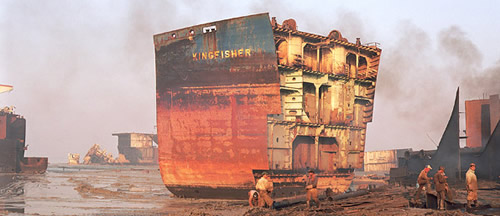The End Of Infamy? Shipbreaking at Alang

Photo by Edward Burtynsky
The Economic Times of India bring us news of the world’s most infamous ship breakers;
The hands that used to work on mammoth ocean liners and crude carriers and generated revenues worth Rs 80,000 crore till 2008 in one of the largest ship-breaking yards, have deserted it. Alang Ship Breaking Yard, on Gujarat’s Bhavnagar coast, which until 2004 could boast of being one of the biggest employers of migrant labour, has lost its men to other clusters as it lost business to Bangladesh. Over a period of four years, numbers have dwindled from 40,000 to about 5,000 migrant labourers.
tagzaniapasteEver since Alang breached its first vessel — MV Kota Tenjong — in 1983, it drew migrant labourers from Mumbai, Orissa, Bihar, and Uttar Pradesh. Alang beached 4,539 ships between 1983 and 2008 and handled tonnage to the tune of 3,19,89400 LDT (light displacement tonnage).
Between 1996 and 2004, whenever large supertankers, container ships or passenger carriers were beached at Alang, it used to resemble a honeycomb with hundreds of manual labourers buzzing around the ships; dismantling them, salvaging what they could and reducing the rest to scrap. During its prime in 1998-99, Alang handled a record 361 ships with 30,37,882 LDT.
“We had close to 40,000 labourers during those days when business was profitable. Now, we are left with hardly 5,000 of them,” says vice-president of the Ship Recycling Industries Association (SRIA) at Alang, Vippin Aggarwal. Close to 95% of the labourers at Alang have been migrants, he points out. Continue Reading…
Not mentioned in the article are newly imposed environmental guidelines set by India’s Supreme Court and scrap metal prices that make ship breaking profitable in places like the UK and US.

Subscribe for Daily Maritime Insights
Sign up for gCaptain’s newsletter and never miss an update
— trusted by our 109,185 members

Get The Industry’s Go-To News
Subscribe to gCaptain Daily and stay informed with the latest global maritime and offshore news

 Join The Club
Join The Club






